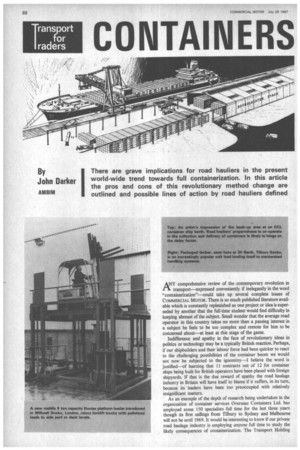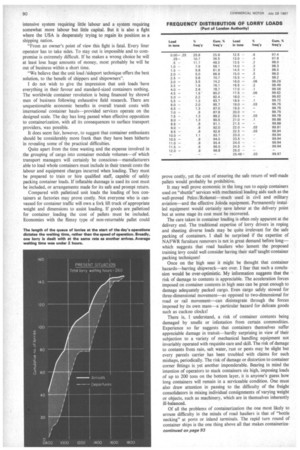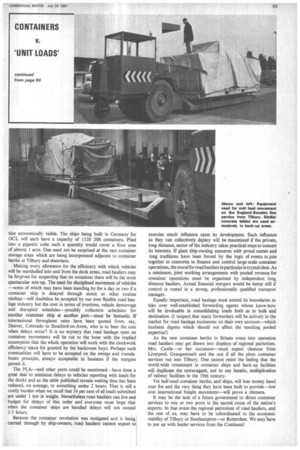CONTAINERS
Page 90

Page 91

Page 92

Page 95

If you've noticed an error in this article please click here to report it so we can fix it.
v. 'UNIT LOADS'
NY comprehensive review of the contemporary revolution in transport—expressed conveniently if inelegantly in the word "containerization"—could take up several complete issues of COMMERCIAL MOTOR. There is SO much published literature available which is constantly replenished as one project or idea is superseded by another that the full-time student would find difficulty in keeping abreast of the subject. Small wonder that the average road operator in this country takes no more than a passing interest in a subject he feels to be too complex and remote for him to be concerned about—at least at this stage of the game.
Indifference and apathy in the face of revolutionary ideas in politics or technology may be a typically British reaction. Perhaps, if our shipbuilders and their labour force had been quicker to react to the challenging. possibilities of the container boom we would not now be subjected to the ignominy—I believe the word is justified—of learning that 11 contracts out of 12 for container ships being built for British operators have been placed with foreign shipyards. If that is the due reward of apathy the road haulage industry in Britain will have itself to blame if it suffers, in its turn, because its leaders have been too preoccupied with relatively insignificant matters.
As an example of the depth of research being undertaken in the organization of container services Overseas Containers Ltd. has employed some 150 specialists full time for the last three years though its first saings from Tilbury to Sydney and Melbourne will not be until 1969. It would be interesting to know if our private road haulage industry is employing anyone full time to study the likely consequences of containerization. The Transport Holding Co. and its road haulage dependencies should not be left to shoulder the whole burden of long-term research for the industry.
A container is, of course, a unit load by another name. The Gadarene rush to containerization has come about because ship-owners, port operators, railways and the more percipient road hauliers have convinced themselves—on the basis of much practical evidence but even more by statistical projections yet to be proved— that a high proportion of all goods moving internationally can conveniently move in boxes.
By no means all ship-owners are fully sold on containerization. Many—even some members of container consortia—would prefer to hasten slowly, believing that conventional cargo vessels and ships specially adapted for unit load carrying offer a viable, and certainly much cheaper, alternative.
Unit load sizes equal in volume to the largest containers now envisaged (4011 x 8ft x 8ft) seem to be entirely practicable— indeed, much larger unit loads could safely be carried from premises adjacent to motorways when dock access roads are widened. (It is sometimes forgotten that railway electrification has reduced the size of heavy loads that can be conveyed by rail, adding grist to the heavy road haulier's mill).
The "Brilliant" class ships of the Oslo based Fred Olsen Lines have a main hatch 69ft 9in long allowing crane stowage of preslung cargo such as steel girders. The main emphasis of Olsen's very successful specialization in unit load movement is on palletized loads of 1-3 tons which are loaded through side ports in the vessel using fork-lift trucks or automatic pallet elevators.
The advocates of full containerization might disparage the relatively small palletized loads carried by Olsen and other unit load ship-owners but it should be remembered that a very high proportion of all exports and imports comprise small lots. More than 25 per cent of the export loads delivered by road to Port of London Authority docks are of less than 5cwt1 Barely 1 per cent are of 10 tons and 20 tons and over-loads comprise a derisory .03 per cent frequency. Small wonder that the market for 40ft containers is felt by many people to be minute in comparison with the more popular smaller sizes.
Containerization on the scale now planned will involve an enormous development of cargo grouping—with all the hazards this must involve in the safe packing of possibly incompatible goods. Unit loads which are more easily packed, more accessible to Customs inspection or other checking en route and with which road hauliers in general are much more familiar offer many attractions. One can well sympathize with the views of Mr. Erik Heirung, vice-president of Fred Olsen Lines, who argued persuasively at the recent Antwerp conference of International Cargo Handling Co-ordination Association that since specialized unit load ships could increase general cargo loading productivity from about 1 ton/man hour (a world average) to 5-10 tons /man hour the heavy capital costs of full containerization was unjustified. His company, he said, had converted conventional 10,000 dwt vessels for unit load operation for sums ranging from £40,000 to £75,000—chicken feed compared with the astronomical investments of international container consortia.
Mr. Heirung's conclusion sums up the containers v. unit loads controversy tersely: "We are viewing a fight between a capital intensive system requiring little labour and a system requiring somewhat more labour but little capital. But it is also a fight where the USA is desperately trying to regain its position as a shipping nation.
"From an owner's point of view this fight is fatal. Every liner operator has to take sides. To stay out is impossible and to compromise is extremely difficult. If he makes a wrong choice he will at least lose huge amounts of money, most probably he will be out of business within a short time.
"We believe that the unit load /sideport technique offers the best solution, to the benefit of shippers and shipowners".
I do not wish to give the impression that unit loads have everything in their favour and standard-sized containers nothing. The worldwide container revolution is being financed by shrewd men of business following exhaustive field research. There are unquestionable economic benefits in overall transit costs with international container hauls-provided services operate on the designed scale. The day has long passed when effective opposition to containerization, with all its consequences to surface transport providers, was possible.
It does seem fair, however, to suggest that container enthusiasts should be considerably more frank than they have been hitherto in revealing some of the practical difficulties.
Quite apart from the time wasting and the expense involved in the grouping of cargo into container module volumes-of which transport managers will certainly be conscious-manufacturers able to load whole containers must include in their transit costs the labour and equipment charges incurred when loading. They must be prepared to train or hire qualified staff, capable of safely packing container loads. If inflatable dunnage is used its cost must be included, or arrangements made for its safe and prompt return.
Compared with palletized unit loads the loading of box containers at factories may prove costly. Not everyone who is canvassed for container traffic will own a fork lift truck of appropriate weight and dimensions to assist loading. If goods are palletized for container . loading the cost of pallets must be included. Economies with the flimsy type of non-returnable pallet could prove costly, yet the cost of ensuring the safe return of well-made pallets would probably be prohibitive.
It may well prove economic in the long run to equip containers used on "shuttle" services with mechanical loading aids such as the well-proved Pelco /Rolamat-much used in civil and military aviation-and the effective Joloda equipment. Permanently installed equipment would certainly save labour at the delivery point but at some stage its cost must be recovered.
The care taken in container loading is often only apparent at the delivery end. The traditional expertise of lorry drivers in roping and sheeting diverse loads may be quite irrelevant for the safe packing of containers. I shall be surprised if the expertise of NAFWR furniture removers is not in great demand before longwhich suggests that road hauliers who lament the proposed training levy could well consider having their staff taught container packing techniques!
Once on the high seas it might be thought that container
hazards barring shipwreck-are over. I fear that such a conclusion would be over-optimistic. My information suggests that the risk of damage to contents is appreciable. The acceleration forces imposed on container contents in high seas can be great enough to damage adequately packed cargo. Even cargo safely stowed for three-dimensional movement-as opposed to two-dimensional for road or rail movement-can disintegrate through the forces imposed by its own mass-a particular hazard for delicate goods such as cuckoo clocks!
There is, I understand, a risk of container contents being damaged by smells or infestation from certain commodities. Experience so far suggests that containers themselves suffer appreciable damage in transit-hardly surprising in view of their subjection to a variety of mechanical handling equipment not invariably operated with requisite care and skill. The risk of damage to contents from rain, salt water, rust or pests may be slight but every parcels carrier has been troubled with claims for such mishaps, periodically. The risk of damage or distortion to container corner fittings is yet another imponderable. Bearing in mind the intention of operators to stack containers six high, imposing loads of up to 200 tons on the bottom layer, it is anyone's guess how long containers will remain in a serviceable condition. One must also draw attention in passing to the difficulty of the freight consolidators in mixing individual consignments of varying weight or objects, such as machinery, which are in themselves inherently ill-balanced.
Of all the problems of containerization the one most likely to arouse difficulty in the minds of road hauliers is that of "bottle necking" at ports or inland terminals. The rapid turn round of container ships is the one thing above all that makes containerizacontinued on page 93 tion economically viable. The ships being built in Germany for OCL will each have a capacity of 1120 20ft containers. Piled into a gigantic cube such a quantity would cover a floor area of almost 1 acre. One need not be surprised at the vast container storage areas which are being incorporated adjacent to container berths at Tilbury and elsewhere.
Making every allowance for the efficiency with which vehicles will be marshalled into and from the dock areas, road hauliers may be forgiven for suspecting that on occasions there will be the most spectacular mix-up. The need for disciplined movement of vehicles —some of which may have been standing by for a day or two if a container ship is delayed through storm or other routine mishap—will doubtless be accepted by our ever flexible road haulage industry but the cost in terms of overtime, vehicle demurrage and disrupted schedules—possibly collection schedules for another container ship at another port—must be fantastic. If international throughout rates have been quoted from, say, Denver, Colorado to Stratford-on-Avon, who is to bear the cost when delays occur? It is no mystery that road haulage rates on container movements will be cut to the bone with the implied assumption that the whole operation will work with the clockwork efficiency taken for granted by the backroom boys. Perhaps such eventualities will have to be accepted on the swings arid roundabouts principle, always acceptable in business if the margins permit it.
The PLA—and other ports could be mentioned—have done a great deal to minimize delays to vehicles reporting with loads for the docks and as the table published reveals waiting time has been reduced, on average, to something under 2 hours. That is still a costly burden when we recall that 56 per cent of all loads submitted are under 1 ton in weight. Nevertheless road hauliers can live and budget for delays of this order and everyone must hope that when the container ships are handled delays will not exceed 2-3 hours.
Because the container revolution was instigated and is being carried through by ship-owners, road hauliers cannot expect to exercise much influence upon its development. Such influence as they can collectively deploy will be maximized if the private, long distance, sector of the industry takes practical steps to concert its interests. If giant ship-owning concerns with proud names and long traditions have been forced by the logic of events to join together in consortia to finance and control large-scale container operations, the moral for road hauliers in particular is crystal clear. As a minimum, joint working arrangements with pooled revenue for container operations must be organized by independent long distance hauliers. Actual financial mergers would be better still if control is vested in a strong, professionally qualified transport manager.
Equally important, road haulage must extend its boundaries to take over well-established forwarding agents whose know-how will be invaluable in consolidating loads both as to bulk and destination. (I suspect that many forwarders will be actively in the market for road haulage businesses on their own account—which business digests which should not affect the resulting pooled expertise!) As the new container berths in Britain come into operation road hauliers may get drawn into displays of regional patriotism. Mrs. Castle—or her successor—must expect clamour from Liverpool, Grangemouth and the rest if all the plum container services run into Tilbury. One cannot resist the feeling that the world-wide investment in container ships and back-up facilities will duplicate the extravagant, not to say lunatic, multiplication of railway facilities in the 19th century.
Yet half-used container berths, and ships, will lose money hand over fist and the very thing they have been built to provide—low cost international freight movement—will prove a chimera.
It may be the task of a future government to direct container services to one or two ports in the sacred cause of the nation's exports. In that event the regional patriotism of road hauliers, and the rest of us, may have to be subordinated to the economic viability of Tilbury or Southampton—or Rotterdam. We may 'have to put up with feeder services from the Continent!




































































































































































